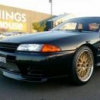Greddy Engine Oil Block Type E - Bnr32
Announcements
-
Similar Content
-
Latest Posts
-
It'll be fine. You're in Canada. Winter is coming.
-
By TurboTapin · Posted
I came into the garage to notice yet again, a couple drops of what seems to be molasses leaking from my right rear wheel well. I originally figured I ran something over and that it was harmless but this time I decided to check, as it was becoming repetitive. It's clearly leaking from the bushing. Not my picture, but this sucker right here. I've never actually seen this in all my years of driving. Our cars aren't getting any younger. I already have GKtech bushings on the shelf, but was hoping to push the work to winter. Once she's blows, is it still doing anything? -
By davemoto63 · Posted
Spotted in Adelaide last week.... mine! New to me two weeks ago.. love it! -
By Dose Pipe Sutututu · Posted
Congrats on the career change! I did something similar at the start of the year too, left IT / corporate after nearly 2 decades. Soooo when's the motor coming out for the spark plug change?





Recommended Posts
Create an account or sign in to comment
You need to be a member in order to leave a comment
Create an account
Sign up for a new account in our community. It's easy!
Register a new accountSign in
Already have an account? Sign in here.
Sign In Now